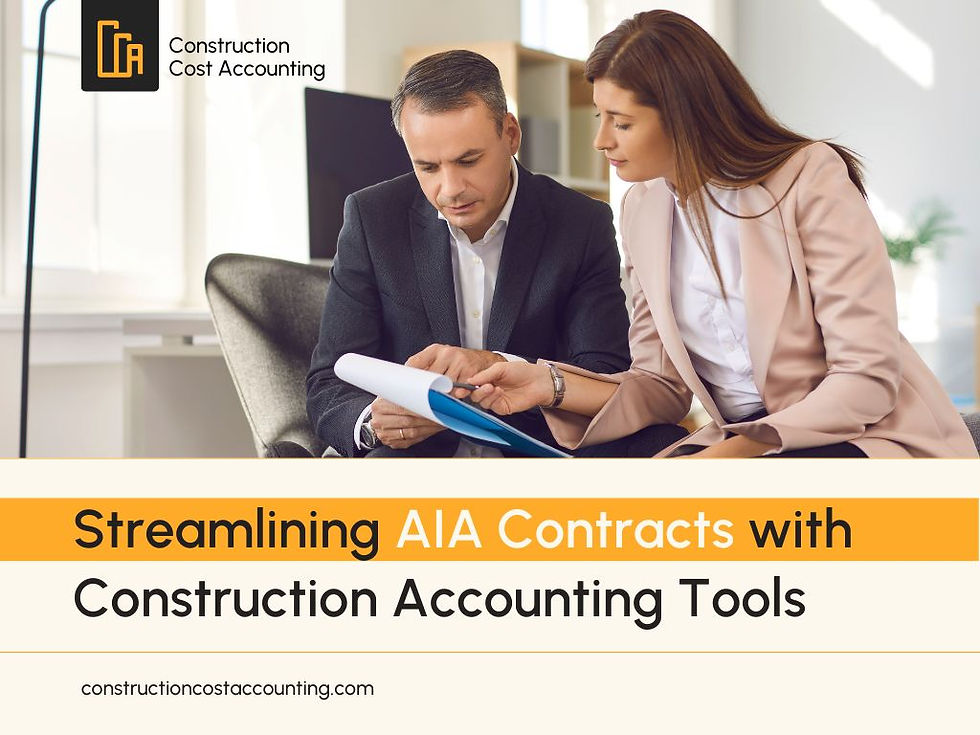AIA Contracts 101: Choosing the Right Agreement for Your Project
- Cost Construction Accounting

- Oct 1
- 4 min read
When embarking on a construction project, selecting the appropriate contract agreement is crucial to ensure clarity, fairness, and legal protection for all parties involved. The American Institute of Architects (AIA) provides a suite of standardized contract documents widely recognized and utilized across the industry. These documents help define the scope, responsibilities, and expectations between owners, contractors, and architects.
This comprehensive guide will walk you through the essentials of AIA contracts, their history, key components, and how to choose the right type for your project. Additionally, it explores how technology can streamline contract management and addresses risk and dispute resolution strategies.

Table of Content:
Understanding AIA Contract Documents
The American Institute of Architects (AIA) contract documents serve as the core foundation for construction agreements. They provide standardized language and provisions that promote consistency, reduce misunderstandings, and are designed to balance the interests of all parties involved.
By using these documents, stakeholders benefit from industry-vetted templates applicable to a wide range of project types. This standardization helps minimize negotiation time and legal ambiguity, simultaneously fostering collaboration as everyone operates from a shared understanding of the terms and conditions.
Key Components
Standard AIA agreements include several critical components that define the project framework:
Scope of Work, Payment Terms, and Project Schedule.
Insurance requirements and dispute resolution mechanisms.
Clear delineation of responsibilities and rights for the owner, contractor, and architect.
This clarity helps prevent conflicts by setting expectations upfront and providing established procedures for addressing issues like delays, force majeure events, and change orders. This structured approach not only enhances accountability but also serves as an essential reference point throughout the project lifecycle.
Key AIA Contract Types: Which One Fits Your Project?
Criterion | Lump Sum (A101) | Cost-Plus (A102) | Time and Materials (A107) |
Contract Nature | Fixed Price | Actual Costs + Fee | Time & Materials + Markup |
Payment Basis | Agreed schedule for total fixed price. | Reimbursement for actual costs plus a fee. | Based on labor hours, material costs, and markup. |
Scope Definition | Clear and detailed scope required. | Flexible for uncertain or evolving scope. | Suitable for undefined scopes, often for small or emergency work. |
Cost Risk for Owner | Low, budget certainty, contractor bears risk. | High, final price not fixed. | High, requires careful monitoring to avoid cost overruns. |
Cost Risk for Contractor | High, contractor bears any cost overrun. | Low, contractor reimbursed for costs and guaranteed profit. | Medium, costs reimbursed but requires detailed documentation. |
Primary Benefit | Simplified finances and incentivizes contractor efficiency. | Transparent costs and flexible for design changes. | Flexibility for urgent work and quick project start. |
Primary Drawback | Low flexibility, change orders needed. | No budget certainty, requires trust and oversight. | Risk of overruns without proper supervision. |
Typical Application | Fixed-scope commercial or residential projects. | Design-Build projects or complex renovations. | Emergency repairs or maintenance. |
Selecting the right contract requires assessing several factors: project complexity, scope definition, risk tolerance, and budget constraints.
For projects with a clear and stable scope, Lump Sum contracts (A101) provide cost predictability and straightforward administration.
Conversely, if the scope is uncertain or expected to evolve, Cost-Plus (A102) or Time and Materials (A107) contracts offer the necessary flexibility.
It is crucial to consult with legal and construction professionals early to align the contract choice with your project's goals and risk management strategy. Early discussions with stakeholders will help ensure a strategic and informed decision.
Streamlining AIA Contract Management with Technology
Managing AIA contracts involves handling complex documents, change orders, schedules, and pay applications (like G702/G703). Technology simplifies these processes, reduces errors, and enhances communication across project teams. Here’s how modern tools streamline AIA contract management:
Centralized Document Storage: Store AIA contracts (e.g., A101, A102, A107) in a secure, cloud-based platform, accessible anytime, anywhere, for seamless project coordination.
Automated Notifications: Receive alerts for critical deadlines, such as pay application submissions or change order approvals, ensuring compliance and timely action.
Digital Signatures and Collaboration: Enable faster approvals with digital signatures and real-time collaboration tools to keep owners, contractors, and architects aligned.
Integration with Accounting and Project Management: Connect AIA contract data with tools like QuickBooks or Procore for a unified view of costs, schedules, and performance.
Mobile Accessibility: Access contract updates and statuses via mobile apps, keeping teams informed, whether on-site in Texas or managing projects in California.
Advanced Analytics: Use data-driven insights to predict issues like scope creep or budget overruns by analyzing historical change orders and project trends.
Conclusion
Selecting the right AIA contract is essential for a successful construction project, ensuring clarity, fairness, and legal protection for all parties involved. Each contract type, whether Lump Sum (A101), Cost-Plus (A102), or Time and Materials (A107) offers unique benefits and is suited for different project scopes and risk levels. It’s important to assess your project’s needs, complexity, and budget to determine the best fit. Additionally, utilizing technology to streamline contract management can significantly reduce errors and improve efficiency, allowing for better collaboration and project oversight.
At Construction Cost Accounting, we specialize in helping construction companies navigate the complexities of contract management, providing automated tools for AIA-compliant invoicing, cost tracking, and financial reporting. Whether you're handling a fixed-price project, an evolving design, or emergency repairs, our services ensure your financial management is seamless and accurate, enabling you to focus on the success of your project. Let us assist you in managing your project’s financial health while ensuring compliance with industry standards and contract terms.




Comments